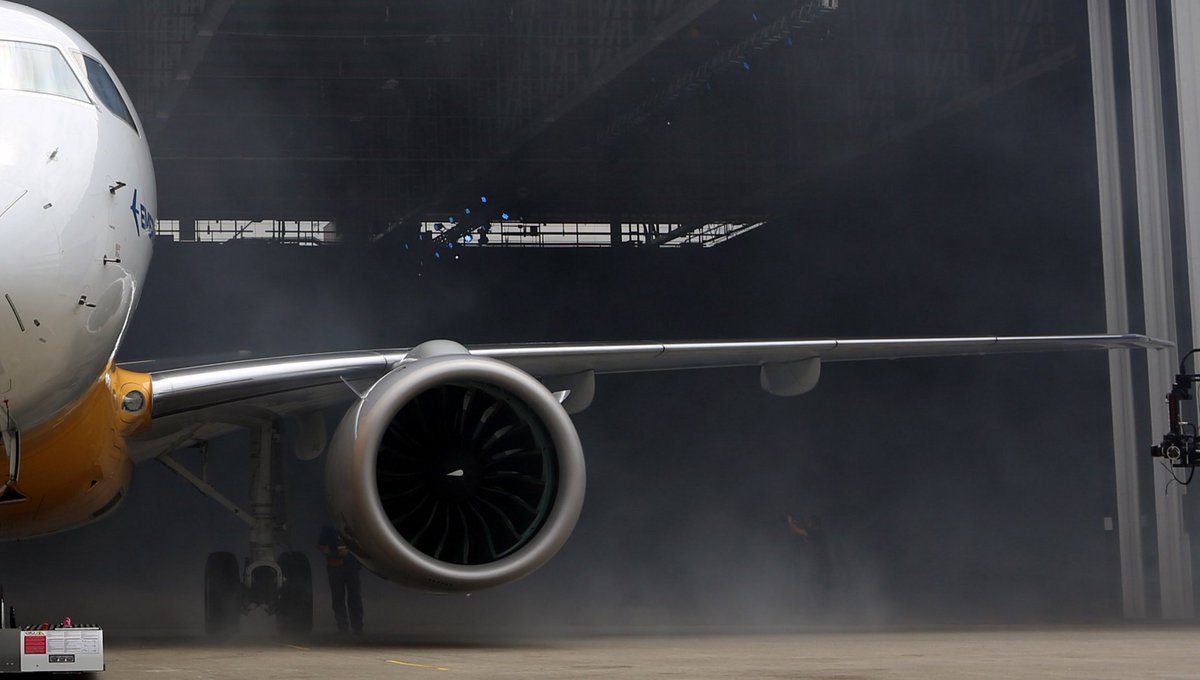Très très peu de composites sur les E-jet
Intéressant, parce qu'au final l'E195-E2 est le plus en concurrence avec les 737-7/A319 et les Cseries qui ont des bonnes allonges...
A regarder
 Re: Embraer E-jet G2 (nouvelle génération)
Re: Embraer E-jet G2 (nouvelle génération) Re: Embraer E-jet G2 (nouvelle génération)
Re: Embraer E-jet G2 (nouvelle génération)The 195-E2 will have an increase in the MTOW for increased range. The wing span is also increased slightly (4.6 ft) for better hot and high performance. The MTOW is increased by 2,000kg.
In hot-high airports, the range improvements are about 250nm.

 Re: Embraer E-jet G2 (nouvelle génération)
Re: Embraer E-jet G2 (nouvelle génération) Re: Embraer E-jet G2 (nouvelle génération)
Re: Embraer E-jet G2 (nouvelle génération) Re: Embraer E-jet G2 (nouvelle génération)
Re: Embraer E-jet G2 (nouvelle génération)

The most notable change to the E2 is the all-new wing. Only other raked-tip in aviation. A Boeing-blessed design? pic.twitter.com/uyfnkuMArI
— Jon Ostrower (@jonostrower) 25 février 2016
 Re: Embraer E-jet G2 (nouvelle génération)
Re: Embraer E-jet G2 (nouvelle génération)Paul a écrit:Il a été dévoilé, le changement le plus notable est la nouvelle aile avec les raked wing tip à la Boeing.
 Re: Embraer E-jet G2 (nouvelle génération)
Re: Embraer E-jet G2 (nouvelle génération) Re: Embraer E-jet G2 (nouvelle génération)
Re: Embraer E-jet G2 (nouvelle génération)
 Re: Embraer E-jet G2 (nouvelle génération)
Re: Embraer E-jet G2 (nouvelle génération) Re: Embraer E-jet G2 (nouvelle génération)
Re: Embraer E-jet G2 (nouvelle génération) Re: Embraer E-jet G2 (nouvelle génération)
Re: Embraer E-jet G2 (nouvelle génération) Re: Embraer E-jet G2 (nouvelle génération)
Re: Embraer E-jet G2 (nouvelle génération) Re: Embraer E-jet G2 (nouvelle génération)
Re: Embraer E-jet G2 (nouvelle génération)We recently sent a series of detailed questions regarding the E2 after the roll-out to clarify key points. Embraer’s replies are in italics.
- Performance improvements E190-E2: Any indication that the increased range and hot and high performance announced for the E195-E2 could also be applied to the E190-E2?
The increased range and H&H performance announced for the E195-E2 is the output of an optimization process focused on the E195-E2 that resulted on a higher aspect ratio wing for that model. There are no current requirements or plans to introduce the new wingtip to the E190-E2.
- E195-E2 wing: The +4.6ft span increase: Are the changes being made to the wing to increase the span via a wing tip extension, wing root plug, or trailing edge modification? Are there any other structural changes required to support the increase in MTOW on the E195-E2?
The increased wingspan is achieved by larger wingtips only and structural changes were required throughout the wing to cope with the new aerodynamic loads. There are no further changes in the aircraft structure.
- E195-E2 OWE increase: Embraer announced a +2,000kg increase in MTOW and a larger wing for the E195-E2, but the max payload looks the same on the PR chart. Can you explain please? Do we know how much the OWE and MZFW increased as part of these changes?
The increased MTOW allows a better use of the fuel tank capacity. More fuel, more range. In this case, the MTOW increase does not impact the payload of the aircraft. There might be a small impact in the aircraft structural weight, but given a higher level of program maturity and a better understanding of the aircraft structural loads, it will be minimal, if any. What is really important is that the maximum payload is unchanged.
- Hot & High improvement: For the E195-E2 expressed as an increase in range (i.e. +250NM from DEN, +280 NM from BOG), do you have any indication on the improvement in TOFL or TOW from these airports at different temperatures? (is there a table you can share?) Is there any information on field performance in general?
The higher aspect ratio wing main outcome is an overall improved performance when there are takeoff limitations associated to WAT/climb, not necessarily impacting the TOFL. The extra range benefit varies depending on the altitude, temperature and airline operational/configuration assumptions. The range increase for Denver and Bogota was calculated using typical assumptions, assuming 85% confidence summer temperatures. Please refer to the attached table for field performance info.

 Re: Embraer E-jet G2 (nouvelle génération)
Re: Embraer E-jet G2 (nouvelle génération) Re: Embraer E-jet G2 (nouvelle génération)
Re: Embraer E-jet G2 (nouvelle génération) Re: Embraer E-jet G2 (nouvelle génération)
Re: Embraer E-jet G2 (nouvelle génération) Re: Embraer E-jet G2 (nouvelle génération)
Re: Embraer E-jet G2 (nouvelle génération) Re: Embraer E-jet G2 (nouvelle génération)
Re: Embraer E-jet G2 (nouvelle génération) Re: Embraer E-jet G2 (nouvelle génération)
Re: Embraer E-jet G2 (nouvelle génération)Des chiffres intéressants pour les gains en consommation.“Our [PW1900G] engine does have some of issues that have been manifested on other applications, but by the time we enter service they will all have been corrected,” Embraer Commercial Aviation COO Luis Carlos Affonso said, speaking at a pre-Farnborough Airshow briefing held at Embraer’s plant in Evora, Portugal on June 28.
Affonso said the comparably smaller size of the E2 engine means the problems have been felt on a “smaller scale.” The A320neo’s PW1100G-JM engine has had to idle for three minutes following startup, but the total start time on the E2 is only 60 seconds.
“When we selected the GTF, we knew it was new technology, which often creates teething problems. But we are not the first application and we have enough time before entry into service for hiccups to be corrected. There is no impact on the flight test campaign and by [E190-E2 entry into service at] the beginning of 2018, it will be a good, a normal start-up time,” Affonso said.
The E190-E2’s GTF engine is 16% more efficient that its predecessor on the E1, although this is reduced to 11% when installed. “The price we pay to install a bigger and heavier engine in the airplane is 5%, so the net gain from the engine is 11%,” he said.
A further 3.5% in savings stems from the new wings, plus another 1.5% from the twinjet’s new fly-by-wire system, taking the total E190-E2 efficiency improvement to 16%.
 Re: Embraer E-jet G2 (nouvelle génération)
Re: Embraer E-jet G2 (nouvelle génération) Re: Embraer E-jet G2 (nouvelle génération)
Re: Embraer E-jet G2 (nouvelle génération) Re: Embraer E-jet G2 (nouvelle génération)
Re: Embraer E-jet G2 (nouvelle génération) Re: Embraer E-jet G2 (nouvelle génération)
Re: Embraer E-jet G2 (nouvelle génération)

 Re: Embraer E-jet G2 (nouvelle génération)
Re: Embraer E-jet G2 (nouvelle génération) Re: Embraer E-jet G2 (nouvelle génération)
Re: Embraer E-jet G2 (nouvelle génération) Re: Embraer E-jet G2 (nouvelle génération)
Re: Embraer E-jet G2 (nouvelle génération)#E195E2 #E2rollout pic.twitter.com/SONW9mM2Eb
— Embraer (@embraer) 7 mars 2017
 Re: Embraer E-jet G2 (nouvelle génération)
Re: Embraer E-jet G2 (nouvelle génération)